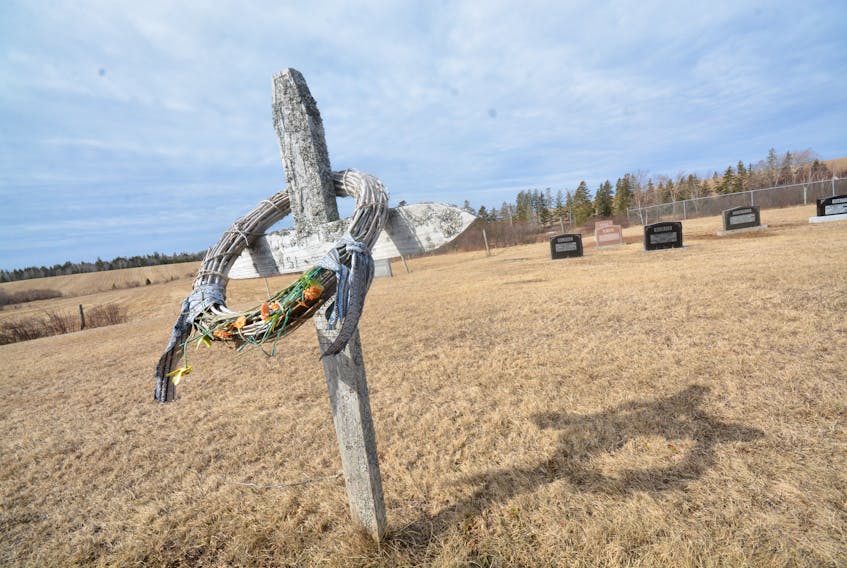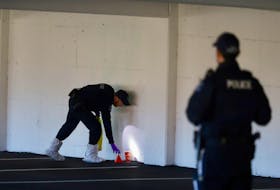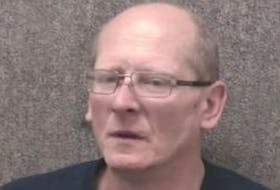Shinimicas – Dotted between destinations throughout Nova Scotia are the small rural churches and cemeteries of a time almost forgotten; supported by hardworking families as the nation was being built.
Time and technology is a fickle thing, however, and the number of people who once looked to these little one-room buildings to celebrate life from beginning to end have changed but the associated cemeteries have not gone anywhere, their fate undecided unless a few are willing to rally together.
In the Route 6 community of Shinimicas, one such group was able to secure their community’s cemetery by forming a not-for-profit society and working with the local church congregation and presbytery to transfer over the ownership of the Shinimicas United Church cemetery.
The lessons learned, they say, could help communities throughout the rest of Cumberland County and Nova Scotia.

“What’s happening right now is we’re running out of ministers,” Shinimicas Cemetery Society president Paul Mahoney says. “When the ministers go all these country churches are closing. When the country churches close, the cemeteries don’t go away.”
In a sooner-than-later admission, the people of Shinimicas chose to plan ahead while they still had a connection with the United Church to work with. A meeting with the congregation who still meet once-a-year for service in the small, one room church reached a consensus they should ask permission to transfer the cemetery to a society whose interests were in preserving the cemetery’s future. Following the church’s approval, the society went into action.
“There has to be a deed. There has to be something for the society to take control of,” Mahoney said. “We had to go through a survey, we had to hire a lawyer. You have to deal with the [Nova Scotia] Registry of Joint Stock Companies and Revenue Canada. You’re looking at a year from the point you start to the point you’re done.”
With the Shinimicas Cemetery a plan was also made to identify plots still available, making it an operable cemetery and not just a preservation effort.
There are highs and lows in the process, Mahoney says, but there are resources to assist and offer guidance along the way. The reward, he said, is a civic pride any small community can have.
“Nothing looks any worse than to drive by an old church and see a cemetery that’s in total disrepair with the headstones tipped over and the place not mowed,” Mahoney said. “If the people in the churches right now don’t start taking action to get something done to look over those cemeteries in the future then they are going to go downhill.”
Downhill does not mean beyond recovery, however.
But it’s not easy.

The Mattinson family cemetery is experiencing a renaissance.
Just a few short years ago it looked like time had forgotten the final resting place of the first Mattinson family to emigrate here from England. The forest had wrapped itself over some tombstones while the sun shining through the trees overhead cast shadows on the taller, stronger grave markers.
Fifteen years earlier the Mattinson family of today visited the one-acre site during a family reunion, more out of curiosity than anything. The seeds for revitalize the cemetery were planted, however, and in October 2015 the family was in a position, they felt, to try and reclaim the cemetery from Mother Nature.
“If we had clearly known all of the steps, we might not have done it,” Nan Armour, a descendant of the Mattinson family-line, said with a hearty and knowing laugh. “But we did the first step, and then the next and then the next. We really got enthused in a big way once we got started.”
Armour and her family had all the problems Mahoney and the Shinimicas Cemetery Society avoided: there was no church or congregation to work with; there was no deed or survey. There wasn’t even a clear understanding who exactly owned the one-acre cemetery in the middle of the forest.
Over the last 100 years the land had left the Mattinson’ hands and it fell to Armour and her family to find out who might have a claim on the property. What was originally thought to be a simple quest grew exponentially in the literal sense.
“The last person who had a deed for the cemetery had died 50 years ago,” Armour said. “His heirs, four of them, then each had an equal claim. But none of them were still alive. The grandchildren, 16 of them, then became the heirs. Each one owned 1/16th of the acre and none of them knew they had a stake in the cemetery.”
The Mattinson, obviously, needed legal advice.
The family didn’t want to turn the burial ground back into a working cemetery but, instead, bring it back to its former glory. This sincerity of their goals turned out to be an advantage and through legal counsel were able to get permission to handle the upkeep of the cemetery from just four or five of the heirs through a quit-claim deed.
“We don't own the cemetery, but we have the legal authority to do work on it,” Armour said.
Unlike the Shinimicas society, the Mattinson family will not be adding any plots or occupants to the cemetery any time soon, but that was never the intention, Armour said. For them, it was a matter of family pride, and the thrill of a good mystery once they got started.
“For some of us we were like dogs with a bone once we got started.”
The process could have been easier, Armour says, and she can see where the Dept. of Communities, Heritage and Culture could streamline the process and create cost savings for future societies.
“Our problems would not have existed if the provincial government would pass legislation that cedes ownership – and deeds – of abandoned cemeteries to the province,” Armour said in a later correspondence. “If that was the case, we would not have had to go the route of the quit claim deed and find all those grandchildren.”

Forming a society and safeguarding the future interests of a small community cemetery is not a lonesome task.
In Cumberland County they enjoy the benefit of the W.B. Wells Heritage Foundation.
Founded more than three decades ago following the passing of William Black Wells, the foundation was bequeathed its initial funding and have invested more than $1.2 million into the preservation and restoration of cemeteries throughout the county as well as supporting cemetery companies and societies.
While the foundation has helped over 100 cemeteries in Cumberland County, administrator Ian MacLean echoes the community of Shinimicas’ concerns for the rest of the region.
“A lot of small cemeteries are owned by small churches and a small congregation, and they are becoming extinct,” MacLean said.
While provincial laws prevent anyone from unlawfully taking over a cemetery are a good thing it can also be a hindrance, but the foundation and its three-decades of experience can help, MacLean said. Provided the congregation or associated church is willing to cooperate.
“We will help a community take over a cemetery but not everyone is willing to have a society takeover,” MacLean said. “Some want to sell it.”
Selling a cemetery to a volunteer group looking to secure its future when the end appears inevitable, MacLean says, is an unpopular notion.
Over the years, the foundation has worked with the province to alleviate some of the costs a society would face, but some expenses and some hurdles cannot be avoided.
“You still have to have a survey and the more in the woods, the more abandoned a cemetery is, the more difficult it is to obtain,” MacLean said.
The foundation’s mandate is to preserve and keep accessible Cumberland County cemeteries, but where the fiscal resources can’t go, their experience and knowledge can. In doing so, the foundation hopes more societies can be created and champion the final resting places of those who helped shaped today through the hard efforts of yesterday.










